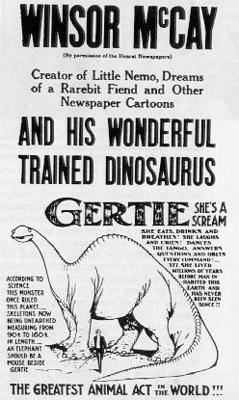(Gertie was actually McCay's third try at animation. His first two short films, featuring a boy (Little Nemo) and a mosquito, were supposedly so convincing to audiences of the time that they thought he'd somehow shot them in real life. So for his third movie, McCay decided to feature a creature he couldn't possibly have filmed live: a dinosaur.)

McCay used his Gertie movie as part of a live vaudeville act in which he interacted with the dinosaur on the screen. She did tricks on command. At one point in the performance, McCay threw food behind the screen that Gertie caught and ate on-screen. At the conclusion, McCay himself "stepped" into the screen and an animated version of the cartoonist took a ride on the beast. By all accounts, the performance was a sensation.
Until the advent of computers, virtually all animation was done on cels, transparent celluloid sheets onto which the characters were inked and painted. Artists only made multiple individual drawings for objects that moved--sometimes an entire figure, sometimes just an arm or mouth. Because cels are transparent, the animators only needed to create one background painting for each scene, on top of which they layered the cels and shot one frame of film. Then they swapped out the bits that moved and shot another frame. Repeat 100,000 times and you've got a movie.
In 1914, they hadn't figured that out yet. In Gertie, Winsor McCay and a single assistant hand-drew both character and background in every frame. Every single frame. They redrew every rock, water ripple, and blade of grass thousands of time on sheets of rice paper that, like tracing paper, were transparent enough to allow them to copy from a master drawing underneath. Then McCay glued each sheet to a piece of cardboard so they all lined up, and shot them.
There are somewhere between 200 and 300 original Gertie cels left. As I said yesterday, until a few years ago I assumed they were long destroyed. Once I discovered otherwise, I learned all I could about them and kept my eyes open. Finally, a couple of weeks ago, everything came together: a beautiful full-figure Gertie pose, good condition, a reputable dealer, and a fair price. I couldn't pass it up. I'd always resolved that I didn't deserve to have a Gertie until I could pay for it with my earnings from cartooning. Thanks to Abrams, that finally came together, too.
To read more about Winsor McCay and Gertie, see
http://www.bpib.com/illustrat/mccay.htm.

2 comments:
That is awesome Brian! Well deserved, congratulations! Lorna
Lorna, thanks! I was happy to solve the mystery for you (I always intended to anyway).
Arnold, thank you for looking up my panel. It would be a real shame to buy the thing and then have you tell me you watched the whole movie and couldn't find it.
McCay was the greatest. I think his "Little Nemo" Sunday pages retain most of their original power; a modern reader can look at them and understand at first glance how amazing he was. The text is often dated (including, unfortunately, racially) but the art still stuns.
Appreciating Gertie takes a little more understanding and education. Her greatness isn't immediately apparent to, say, a layperson (or wife) who sees a simple line drawing of a dinosaur. Gertie isn't "The Little Mermaid" anymore than Edison's first phonograph is a 5,000-watt 11-speaker surround-sound audio system. But I'd rather have the Edison.
Post a Comment